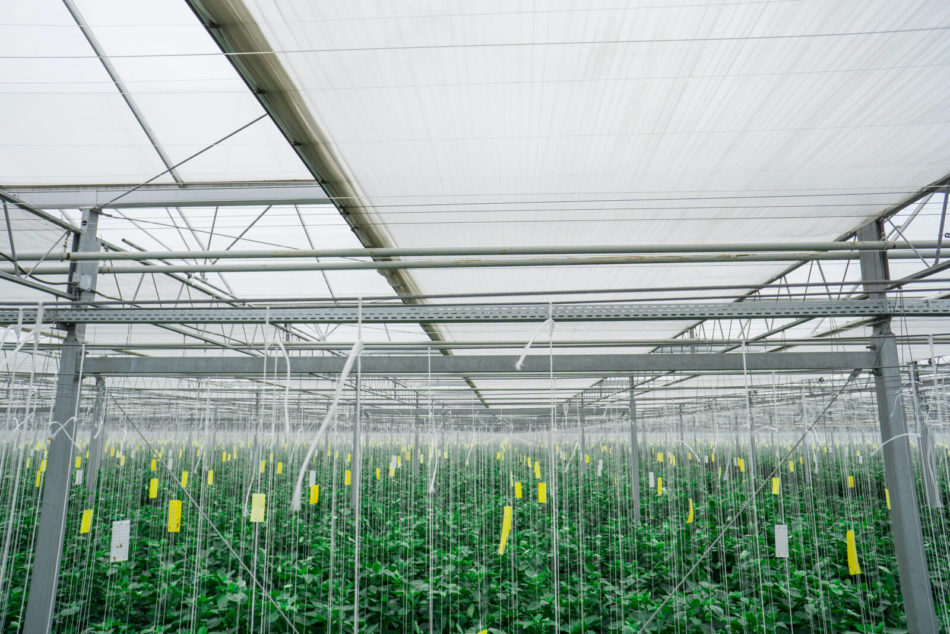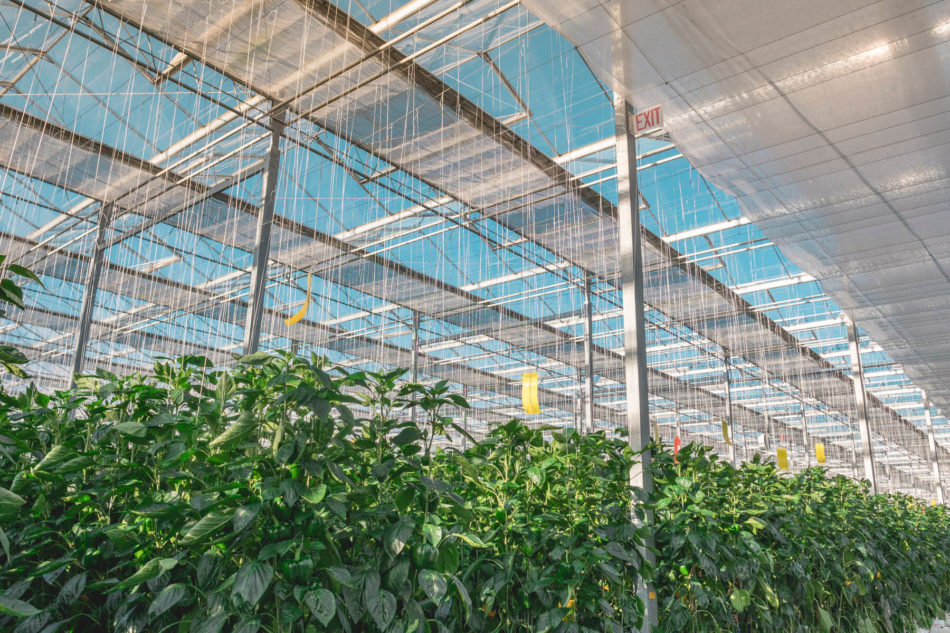
Climate screens are also called greenhouse energy curtains or energy screens. It's installed horizontally above the crop and on top of greenhouse under glass or poly films. Energy screen technology has become a necessary part of greenhouse operational design – these curtains play an important role in conserving energy, managing greenhouse climates, and helping us grow year-round.
WHAT ARE GREENHOUSE CLIMATE SCREENS?
Energy screens are polyester cloth curtains installed horizontally to span the entire area of a greenhouse – they are placed above the crop and below the greenhouse peaks. Where the screens are installed, there is still about two meters of open space between the maximum height of the crop and the bottom of the polyester cloth screen – this ensures our plants are still able to grow to their maximum height.
Energy screens provide a translucent divider that comes between the crop and the sun’s rays. When choosing what energy screen to install, it’s important to choose a screen that strikes a good balance between the amount of light it lets in to the greenhouse and the amount of energy it saves. There are many different energy screen types to choose from, so it’s important for our Growing team to know the pros and cons of each type to make an educated decision.
Almost all commercial-sized greenhouses built today are made of glass – this is because glass structures allow more natural sunlight to enter the greenhouse, which generally results in higher production levels from the crops. Although glass lets in more sunlight, it is not known for its properties as an insulator. This is why energy screens have become an important technology used in glass greenhouses – they help keep cold air out of the greenhouse, and warm air inside of it. Without energy screens, we would not be able to effectively maintain desired temperatures within our glass greenhouses all year round.

WHEN DO WE USE CLIMATE SCREENS IN OUR GREENHOUSES?
Climate screens are used strategically throughout the year for different purposes, depending on a Grower's crop strategy.
When energy screens are closed, a barrier is created that keeps warm air inside a greenhouse, and cold air trapped between the top of the cloth and the greenhouse peaks. The screens also act as a shade when they are closed. When energy screens are open, internal greenhouse temperatures can fluctuate and air can freely circulate.
WINTER GROWING
Climate screens are used the most throughout the coldest months of the year. During the winter, energy screens closed will keep warm air inside the greenhouse and cold air out. The use of energy screens is also important during the winter months to conserve energy – colder external temperatures mean we need to keep as much heat inside the greenhouse as possible, and the less heat we must create ourselves, the more energy we save.
Since energy screens keep warm air within the greenhouse, it doesn't need to create as much heat using natural gas or biomass boiler systems when the energy screens are closed. Without the help of energy screens, it would need to use over 40% more energy than is currently used if we wanted to create optimal growing conditions for our plants.
SPRING & FALL GROWING
During the spring and fall, when temperatures outside are not drastically warm or cold, energy screens be used as shade curtains during the day. This helps to protect the crops from getting sunburnt while still maintaining proper internal temperatures in facilities.
SUMMER GROWING
In the summer, there is more than enough natural heat created by the sun, so energy screens are not closed during hot summer days – if the screens are used at this time, they would keep too much warm air inside the greenhouse and negatively alter the internal climate.or more sunlight to directly hit the crop, which means it is easy for a crop to get too much sunlight. By providing shade for the plants using energy screens, our crops are given an opportunity to rest and are protected from getting sunburnt.

An important part of controlling the climate in glass greenhouses involves implementing an energy screen gapping strategy. A gapping strategy allows for humidity and temperature levels to be managed – when energy screens are closed, and the temperature is becoming too warm inside the greenhouse, Growers can open the screens at a certain rate to slowly let cooler air enter the greenhouse environment.
There are sensors placed inside the peaks of greenhouses that communicate temperature levels . Growers can read these levels and open or close the screens accordingly. By reading this data, Growers can ensure temperature shifts in the greenhouse are implemented smoothly and at a gradual pace – if temperature shifts are too abrupt, the crops can't properly adjust to the change and may be damaged or stressed.


